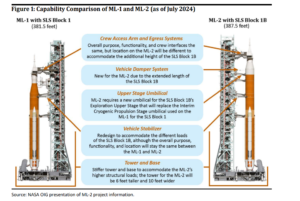NASA IG Issues Another Harsh Report On NASA Management of Mobile Launcher-2
NASA’s Office of Inspector General is again expressing deep concern about NASA’s management of Mobile Launcher-2, an enormous structure needed to haul Space Launch System rockets to the launch pad for the Artemis program. A report two years ago blamed both the prime contractor, Bechtel, and NASA for poor management. NASA itself now estimates the cost will be more than three times what was planned with delivery over four years late, but the OIG thinks it will be a lot more money and even later.
The scathing OIG report issued in 2022 echoed concerns raised by NASA Administrator Bill Nelson about Bechtel, but criticized NASA, too. The new report is similarly blunt.
The OIG continues to criticize NASA for delays in producing an “Agency Baseline Commitment” or ABC for the ML-2 program where the agency commits to Congress on a project’s cost and schedule. NASA must provide a rationale for continuing a project if it exceeds the ABC by certain thresholds and win congressional approval.
ML-2 is needed for the upgraded version of the SLS rocket, Block IB. The ML-2 program began in 2019, but NASA produced the ABC only two months ago in June 2024.

In 2019, the estimate was $383 million with delivery in March 2023. Now that NASA is making a formal commitment to Congress, it’s a much higher cost and longer time frame: $1.8 billion with delivery in September 2027.
The OIG doesn’t believe those numbers. It estimates the cost will be $2.7 billion with delivery in the spring of 2029, beyond the date NASA plans to launch Artemis IV, the first mission that needs ML-2. Artemis IV is scheduled to be the second human landing on the Moon since the Apollo era. Artemis III will be first in September 2026 and then Artemis IV in 2028.

With the extra capacity of the Block IB SLS and the Orion crew spacecraft it carries, Artemis IV will also deliver portions of a small space station, Gateway, that NASA and international partners are putting in lunar orbit.
The weight of the Block IB SLS and its cargo is too much for the existing Mobile Launcher, constructed in 2010. It was used for the uncrewed Artemis I test flight in 2022 and will be for Artemis II next year to send four crew members around the Moon, and Artemis III in 2026, but Block IB is planned for subsequent missions.

If ML-2 and SLS Block IB aren’t ready in time, Artemis IV will be delayed. (The OIG issued a highly critical report about management of the Block IB program earlier this month.)
The bottom line is that the OIG continues to fault both NASA and Bechtel for not managing ML-2 properly with resulting cost overruns and schedule slips.
Unlike many of NASA’s programs these days, this is a cost-plus contract where NASA has to pay for any overruns. The OIG found that the current $1.1 billion contract with Bechtel “includes $594 million of Bechtel overruns.”
By contrast, NASA has a firm fixed price contract with Boeing for the troubled Starliner program and Boeing must pay for overruns. They have cost the company $1.6 billion so far.
In criticizing Bechtel by name two years ago, Nelson complained about the fact it is a cost-plus contract. However, the OIG reports that NASA has decided not to try to convert to a fixed price contract.

NASA pushed back on the OIG’s estimate that the cost will be $2.7 billion and delivery delayed until 2029. In an appendix to the report, Associate Administrator for Exploration Systems Development Cathy Koerner insisted that Bechtel has “transitioned to a different phase of the project” and using a “straight-line projection” as the OIG did “misses this key advancement, overlooks recent performance improvements, and does not provide a credible estimate of what we can expect in the future.” It stands by the estimates in the just-produced ABC.
The OIG concedes that having decided against the possibility of switching to a fixed price contract, NASA’s only mechanism for incentivizing better performance by Bechtel is through award fees — the “plus” in cost plus contracts where contractors are given extra money for good performance. The contract sets an amount for periodic award fees, NASA then awards up to 100 percent depending on how well the company performed during that period.
From July 2019 to September 2023, NASA awarded the company $11.2 million out of $23.3 million that was available. Bechtel received no award fees in three periods, 4, 6 and 7. The OIG is questioning nearly $3 million of what was awarded in periods 8 and 9 “despite multiple documented performance weaknesses.” The OIG adds that NASA and Bechtel revised the evaluation plan in March 2024, but it is too early to determine how well it will work.
Then-Vice President Mike Pence, as chairman of the White House National Space Council, initiated the Artemis program in March 2019, directing NASA to put astronauts back on the Moon by 2024, the end of a second Trump term if he had won reelection. He did not, but incoming President Biden embraced the program and, initially, the 2024 deadline. It has steadily slipped since then, with September 2026 as the latest goal for the first landing. Unlike Apollo, Artemis is designed not for just a few landings of a few days each, but the beginning of long-term exploration and utilization of the Moon along with commercial and international partners. The SLS Block IB and ML-2 are key to accomplishing those goals under the current program plan.
User Comments
SpacePolicyOnline.com has the right (but not the obligation) to monitor the comments and to remove any materials it deems inappropriate. We do not post comments that include links to other websites since we have no control over that content nor can we verify the security of such links.